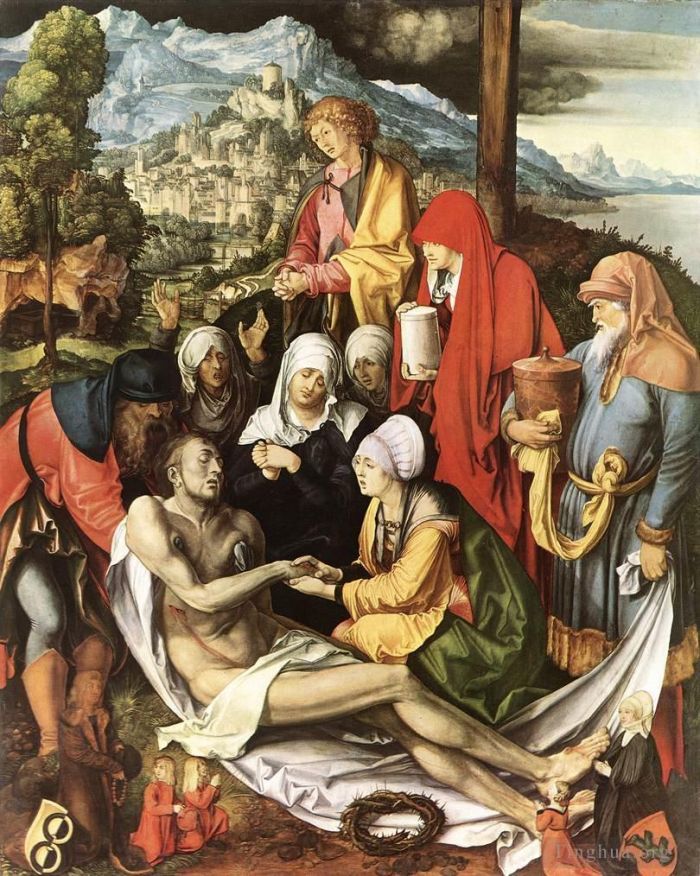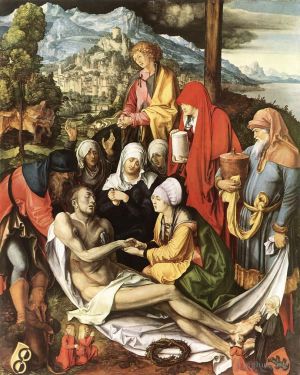Lamentation for Christ
Albrecht Durer
- Price: Price on Request
- Art Type: Oil Painting
- Size:
- English Comments: 0
- International Comments: 0
- Creating Date:
- Introduction and Works of Albrecht Durer >>
Keywords:
Lamentation, Christ
Work Overview
- Lamentation of Christ (Glimm Lamentation)
Artist Albrecht Dürer
Year c. 1500
Medium Oil on panel
Dimensions 151 cm × 121 cm (59 in × 48 in)
Location Alte Pinakothek, Munich
Lamentation of Christ (also known as Glimm Lamentation) is an oil-on-panel painting of the common subject of the Lamentation of Christ by the German Renaissance artist Albrecht Dürer, executed around 1500 and now in the Alte Pinakothek of Munich, Germany.
The work was commissioned by goldsmith Jakob Glimm as a memorial of his first wife, Margaret Holzmann, who a died in 1500. The removal of later re-painting in 1924 showed the original figures of the donors (Glimm and his three sons) and of the dead woman, depicted in far smaller proportions than the religious characters.
The painting shows the dead Jesus, held by Nicodemus and surrounded by the Pious Women, including an aged and distraught Mary. In the right part are three standing characters depicted on a diagonal line: from top, St. John the Evangelist, Mary Magdalene and Joseph of Arimathea, the last two holding vases which contained balms used to prepare the corpse for the burial.
This panel was dedicated by Albrecht Glimm, the goldsmith, to his first wife, Margareth Holzhausen, deceased 22 October 1500. The Dürerian monogram and the date 1500 had once been on the lower edge of the sudarium.
The lamentation scene, composed of nine figures under the cross, occupies almost the entire painting. This scene is framed above by a beautiful landscape in which Jerusalem can be seen off the lakeshore, atop a hill, in the foreground. Behind the city is a mountain peak and a mountain range that disappear into the background. The city, mountains, and lake are flooded with light. A thick blanket of heavy black clouds that thins out just above the lake in the back looms over the mountains. While the presence of the black clouds is justified by the narration of the crucifixion ("and darkness came over the whole land...while the sun's light failed," Luke 23:45), and the light is explained by the words of the apocryphal gospel of Saint Peter when he describes the position ("and the sun began to shine again ", 6:21), the Jerusalem that appears in the painting - a city near water, with house, towers, and fortification walls, lying against rocky mountains - is decidedly an invented, Nordic city, which does not at all reflect the actual appearance, well known at that time, of this blessed city. In the centre, one sees the door that opens into the garden of Gethsemane. A little more ahead, on the right, is the entrance to the tomb in the rock, through which one can spot the uncovered sarcophagus. The first thing that strikes the spectator is the chorale composition of the sufferers around the figure of Christ.
One subsequently perceives the landscape, almost as if it were a second component of the painting. At this point, the two components together make the visual field explode.
The image of the lamentation is from a Dutch, not a German, tradition. Dürer interprets it in Italian terms, associating, in the composition of the scene, the figures three by three: Nicodemus, Magdalene, and Saint John the Evangelist align themselves in an ascending order under the cross. In the centre, the head of the Madonna, while she wrings her hands, is joined by the heads of the other two Marys, who cry with her, the three representing three ages of life.
Last is Joseph of Arimathea, who supports the body of Christ with the sudarium. The image of the body is particularly impressive for the deathly pale colour and for the complete abandon of the lifeless parts. Another Mary stands out for her clothing, fashioned from Dürer's period. She is weeping while holding Christ's hand.
Thus, a triad is formed, be it with the head of Christ and the Madonna, or of Christ and Joseph of Arimathea. The impression of these different triads contrasts with the great chromatic variety of the clothing. However, the rhythm that characterizes the harmonious composition of the figures is not to be found in the colours, since the exaggerated dimensions of the ointment vases breaks the regularity of the proportions, which is otherwise fairly consistent.
The beauty of the work lies chiefly in the depiction of the individual physiognomies and in the gradation of pain: from Magdalene's tear-stained eyes, to the expression of muted and composed suffering of almost all the rest of the figures, to the absolute desperation, shown by the gesture and wailing of the woman next to the Madonna.
The scene with the body of the dead Christ opens up toward the spectator, so that he can directly participate in the lamentation, following the Mary, clad in Renaissance attire, who lovingly clutches the hand of Christ. Since the entire scene is illuminated by a limpid "new light," the suffering of the lamentation is accompanied by a feeling of comfort, a feeling that Dürer makes delicately transpire from the John and Magdalene, whose hopeful gazes are turned toward this light. This, apparently, is the Christian message of the panel. According to an enduring medieval tradition, the figures of the donors are painted, kneeling at the bottom of the scene: on the right, the position of honour, the goldsmith Albrecht Glimm with his coat of arms and two sons; to the left, the late consort with her own coat of arms and daughter. A crown of thorns lies in the middle, between the two groups.
- Copyright Statement:
All the reproduction of any forms about this work unauthorized by Singing Palette including images, texts and so on will be deemed to be violating the Copyright Laws.
To cite this webpage, please link back here.
- >> English Comments
- >> Chinese Comments
- >> French Comments
- >> German Comments
- >>Report
- Emperor Charlemagne
- Virgin Suckling the Child
- Emperor Charlemagne and Emperor Sigismund
- The Apostles Philip and James
- The Cross
- Salvator Mundi
- The Dresden Altarpiece
- St Peter
- Portrait of Emperor Maximilian I
- Alliance Coat of Arms of the Durer and Holper Families
- Portrait of Jacob muffle
- Saint Jerome (St Jerome in the Wilderness)
- Paumgartner Altar right wing
- Portrait of St Sebastian with an Arrow
- Portrait of a Boy with a Long Beard
- Adam and Eve
- The Jabach Altarpiece
- Suicide of Lucretia
- The Seven Sorrows of the Virgin
- Portrait of Oswolt Krel full
- Self-Portrait (Portrait of the Artist Holding a Thistle)
- Four Apostles
- Portrait of a Young Man
- Lots escape
- Portrait of a Man 1504
- Portrait of Hieronymus Holzschuher
- St Jerome
- Twelve year old Jesus in the Temple
- Circumcision of Jesus (Seven Sorrows The Circumcision)
- John
- Christ as the Man of Sorrows
- Holy Family
- The Dresden Altarpiece central panel
- Christ among the Doctors
- Sylvan Men with Heraldic Shields Albrecht Durer
- Job and His Wife
- Maria with child
- The Four Apostles left part St John and St Peter
- The Seven Sorrows of the Virgin The Flight into Egypt
- Portrait of Elector Frederick the Wise of Saxony
- Paumgartner Altar left wing
- Portrait of Elsbeth Tucher
- The Virgin Mary in Prayer
- Ecce Homo
- Portrait of Barbara Durer
- The Madonna of the Carnation
- Portrait of a Young Furleger with Her Hair Done Up
- Combined Coat of Arms of the Tucher and Rieter Families
- Paumgartner altarpiece
- Portrait of a Young Furleger with Loose Hair
- Adoration of the Trinity (Landauer Altarpiece)
- Portrait of Durers Father at 70
- Portrait of a Man 2
- Two Musicians
- The Seven Sorrows of the Virgin Mother of Sorrows
- Portrait of a Young Venetian Woman
- Felicitas Tucher nee Rieter
- Albrecht Portrait of a Man
- Self-Portrait (Self-Portrait with Fur-Trimmed Robe)
- Virgin and Child before an Archway
- Madonna and Child Haller Madonna
- Virgin and child holding a half eaten pear
- The Dresden Altarpiece side wings
- Lot and His Daughters (Lot Fleeing with his Daughters from Sodom)
- Madonna with the Siskin
- Drummers and pipers
- Self-Portrait at 26
- Face a young girl with red beret
- Hans Tucher
- The flight to Egypt Softwood
- Lamentation of Christ
- Hercules kills the Symphalic Bird
- Portrait of the Elder
- Seven Sorrows Crucifixion
- Eve Renaissance
- Avarice
- Virgin and Child with Saint Anne
- Adoration of the Magi
- Martyrdom of the Ten Thousand
- The Lady of the festival du Rosaire
- Emperor Sigismund
- Sylvan Men with Heraldic Shields
- Portrait of Oswolt Krel
- Lamentation for Christ
- The Wire-Drawing Mill
- Primula
- The tuft of grass MINOR
- Garza
- The Little Owl
- Crucifixion
- Cervus Lucanus
- View of Nuremberg
- Lobster
- The Holy Family in a Trellis
- Nuremberg Woman Dressed for Church
- The Castle at Trento
- Innsbruck
- House by a Pond
- Head of an Angel
- Courtyard of the Former Castle in Innsbruck with Clouds
- Lion
- Iris
- Hands
- Hand
- Cupid the Honey Thief
- Self portrait at 13
- View of the Arco Valley in the Tyrol
- Head of a Stag
- The Trefileria on Peignitz
- Arion 2
- Arion
- Knight On Horseback
- A Young Hare
- The Trefileria on Peignitz 2
- Pond in the wood
- Dry dock at Hallerturlein Nuremberg
- Willow Mill
- The Prodigal Son
- View of Kalchreut
- Saint John Church
- Iris Troiana
- The Fall
- Doss Trento
- Innsbruck Seen from the North
- Hare
- Tilo on the cantilever of a bastion
- Courtyard of the Former Castle in Innsbruck without Clouds
- Dead Bluebird
- Map of the Southern Sky
- The city of Trento
- Three Mighty Ladies from Livonia









 Singing Palette
Singing Palette